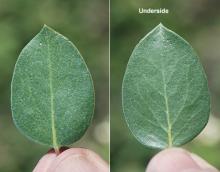Arctostaphylos manzanita
Common name:
Parry Manzanita
Common Manzanita
Pronunciation:
ark-tow-STAF-i-los man-za-NEET-a
Family:
Ericaceae
Genus:
Type:
Broadleaf
Native to (or naturalized in) Oregon:
No
- Broadleaf evergreen shrub or small tree, 6.5-25+ ft (2-8+ m) tall, crooked branching habit, may form dense thickets; does not form a burl. Stems purplish-red, smooth to finely pubescent. Leaves alternate, simple, erect, 2-5 cm long and 1-3.5 cm wide, generally broadly ovate, base rounded to wedge-shaped, tip mucronate (short abrupt point), margin entire, both surfaces similar, bright green, shiny, glabrous, smooth, petiole 6-12 mm long. Flowers small, urn-shaped, white to pinkish, in dense, pendulous clusters to 3 cm, at ends of branches. Fruit a flattened sphere, 8-12 mm wide, glabrous to hairy, white then red-brown.
- Sun or part shade. Some consider it the best all-around manzanita.
-
Hardy to USDA Zone 8 Native to California, North Coast Range, foothills of the Cascades and Sierra Nevada mountains, and San Francisco Bay Area.
- ‘Dr. Hurd’ - a tree-like form, 12-15 ft (~3.5-4.5 m) tall, similar width, open, up swept stems, mahogany bark, large leaves, white flowers.
- ‘St. Helena’ - stout, widely spreading trunks, bright cinnamon bark, gray green leaves, white flowers.




